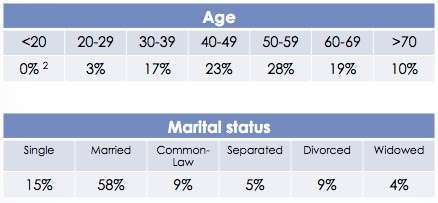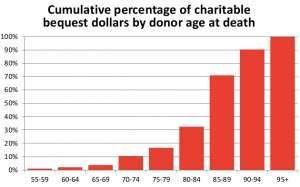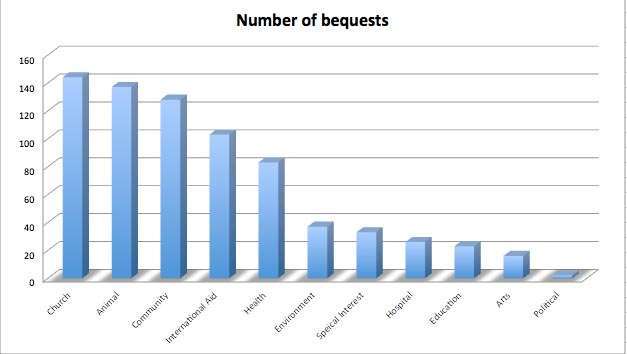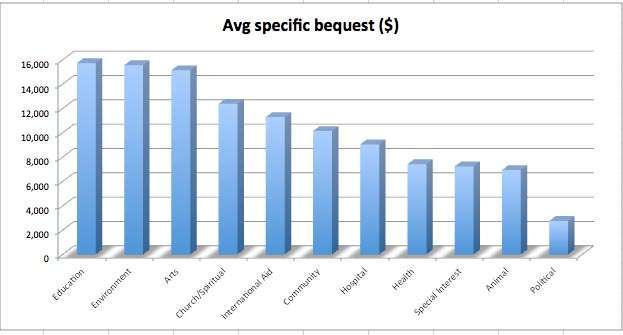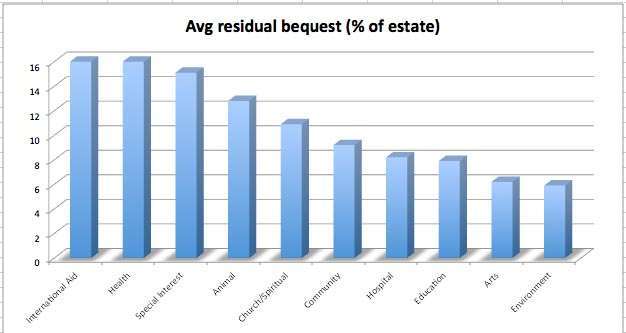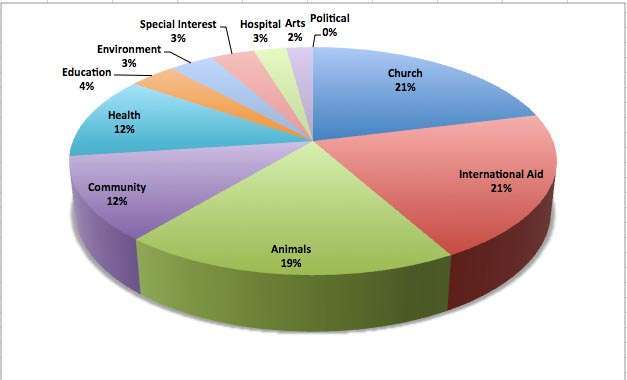“A note on Privacy: the protection and security of the documents created on our web site are of critical importance. In particular, we cannot access any information contained in a specific Will, nor can we read a person’s Will. However, we are able to access aggregated data from an encrypted database folder that summarizes the number of times particular choices have been made within our service. We cannot connect this information to individual accounts. It is this data that has been mined to provide the information in this post”
At LegalWills.ca we help tens of thousands of Canadians create their Last Will and Testament, probably more than any other organization in Canada. Last year, we started to educate ourselves on the state of “planned giving”, that is, leaving something to charity in your Will. According to the most recent Statistics Canada report, both the amount donated to charities by taxfilers and the number of people reporting charitable donations fell from 2011 to 2012. Donations reported by taxfilers declined 1.9% to $8.3 billion in 2012, while the number of people reporting charitable donations on their 2012 income tax return decreased by 1.4% to 5.6 million. Around 23 percent of all tax filers include a charitable bequest in their tax declarations for any given year.
Although charitable giving may be on the decline, we were interested in the level of “planned giving” that is, the charitable bequests that are included in a Last Will and Testament. Sadly, we couldn’t find any good recent statistics on planned giving in Canada, but this website claims that in 2004, 4% of Canadians left a charitable gift in their Wills.
This corresponds with the more up-to-date statistics coming out of the US where it turns out that although 85 percent of people are charitable in their lifetime, only about 5.7 percent of adults over the age of 55 have a charitable estate plan.
So although there are professional member organizations dedicated to promoting planned giving, and thousands of people working in the sector, it seems that 95 percent of Canadians are not including charitable bequests in their Wills.
Clearly, this statistic is a little misleading because we know that more than half of those people don’t even have a Will, and the charitable estate plans are only likely to be created by people with a Will in place; no Will means no planned giving.
At the beginning of 2014, we heard of a study from the UK that suggested appropriate prompting at the time of writing a Will could increase the level of planned giving threefold, and double the average size of charitable bequest.
After hearing about this study, we realized that at LegalWills.ca we had missed an opportunity to promote charitable giving within our service and immediately implemented a charitable bequest page that all users of the service would see when preparing their Will.
The inclusion of this page also allowed us to run some statistics on planned giving within Canada.
Customer and business confidentiality precludes us from providing specific detail on charitable bequests but we are able to provide some generic reports that offer some valuable insight into the state of planned giving in Canada. These statistics were pulled from the last few months, and are drawn from over 10,000 Wills created through our service.
These are real Wills, created by real Canadians. These are not survey results, or information gleaned from questionnaires. Clearly Wills can be updated throughout one’s lifetime, so there is a chance that bequests will be added or removed from these Wills. These statistics therefore provide a snapshot.
It is also worth noting that we offer an affordable estate planning service, so it is likely that very high net worth individuals would not be using our service. Having said that, there were bequests of $250,000 in some Wills created using our service. We know that although we do not necessarily service the top 1 percenters, the remaining 99 percent are open to using our service.
A study of probate records in Australia showed that when they compared self written Wills, Wills prepared through a kit, online software or Wills prepared by a legal professional
Analysis indicated that there is no statistical relationship between the form in which a will is prepared and the likelihood of including a charitable bequest.
In other words, the level of planned giving was not statistically different whether the Will was prepared using an online Will service like ours, compared to having a Will prepared with a lawyer.
Some key demographics
Our users are almost exactly split 50:50 Male:Female. Although age is not a required piece of information, of those that provide their age, the split is as follows
Aggregate charitable gifts
For users of LegalWills.ca for the period of this snapshot in 2014, 3.7% of users included a charitable bequest in their Will. It is important to note that the bequest to charities prompt within the service did not make reference to any particular charity. Although we were happy to include specific charities in this prompt, we were surprised that not many charities wanted to collaborate with us in promoting charitable giving. We are confident that this number could have been increased with more active participation from charitable organizations. It is perhaps surprising that 96.7% of users of our service saw this prompt and decided that they didn’t want to make a charitable bequest in their Will.
This number is way below the industry reported percentage of charitable estate plans. We are reporting that of the people who have prepared a Will, only 3.7% have included a bequest to charity. It is possible that this is a result of 70% of our users being under the age of 60. According to Russell James, 80% of all charitable bequests come from people dying over the age of 80, and only about 2% of charitable bequests come from decedents under the age of 60.
In addition, a report from Australia revealed that 31% of all charitable bequests were signed within 2 years of death.
Nature of our bequests
Of the bequests, just by frequency, 55% were specific sums of money, 38% were a percentage of the residual estate and 7% were bequests of specific assets.
Classifications of planned giving
We struggled to find an industry standard classification for charitable sectors, so we divided the bequests into logical sectors including
Animal – incorporating veterinary hospitals, animal rescue, humane societies and other wildlife organizations
Church/spiritual – included all religious denominations from specific churches to religious leaders
Health – we separated this from hospital foundations, but it includes charities focussed on individual conditions e.g. cancer, diabetes, AIDS, Heart and Stroke, Alzheimers etc
Hospital foundations – a self explanatory group including any hospital but excludes general health charities listed in the category above. There was some debate about collapsing this with the health sector, but we decided to keep them separate.
Community – this included any charities working to improve the places where we live e.g. feeding the hungry, missions, shelters, girls and boys clubs, children’s charities, and we also included United Way, Salvation Army and the Lions clubs in this sector. These include faith based charities with mandates to improve society, but distinct from the church/spiritual category that include bequests to benefit the actual organization.
Environment – This included conservation charities in this category if they were not animal related e.g. the Bruce Trail, parks and wilderness, David Suzuki Foundation, Ducks Unlimited.
International Aid – this is a general grouping of charitable bequests that are likely to be diverted overseas e.g. World Vision, Oxfam, Doctors without Borders, Amnesty International etc
Arts – included any art galleries, museums, choirs or other musical organizations
Education – this includes all universities, schools and colleges
Special Interest – We included this category to capture donations to small professional bodies, memorial funds, clubs, societies and hobby groups.
Politics – we decided that political parties didn’t really fit into any of the categories, and so bequests to political parties have their own category.
Although some organizations blurred the lines between categories e.g. a church based charity focusing on worldwide heath issues, we counted each bequest only once, and so each bequest can only appear in one category.
Frequency of planned giving
The church and spiritual organizations received more bequests that any other charitable sector, followed by animal and community groups.
Value of bequests
In our service, we allow three types of bequest; a specific item e.g. a car, clothes, house, a specific sum of money, or a percentage of the residual estate.
Again, the study of probate records in Australia reported that:
Charitable bequests made as a specified $ value gift were on average significantly lower in value than those made as a residual of the estate:
- $7,000 median value of specified charitable bequests
- $200,000 median value of residual bequests.
For this report, we separated the specific sums to see the average size of a monetary legacy to each charitable sector. Across all bequests, the average charitable donation given as a specific sum of money was $10,061 with the following breakdown.
It would appear that although education (university, college and high school funds) did not receive many bequests, they were on average the highest of any charitable sector. Animal charities receive a very large number of relatively smaller bequests.
However, the very large bequests are in the form of percentages of residual estates. If a person leaves 10% of their estate to a charity they are probably leaving a legacy of tens of thousands of dollars. When we looked specifically at the percentage of residual estates, we saw the following breakdown.
Across all residual bequests, the mean average bequest was 12.1% of the estate. According to our data, International aid and Health received the largest bequests from residual estates.
Total distribution across charitable sectors
We attempted to summarize the distribution of planned giving to charitable sectors, but to do this we needed to give an estimated value of the residual percentage bequests. We took net worth averages from StatCan and combined this with life expectancy data to give us an estimated mean average estate size of $450,000. This actually corresponds well with the analysis of Australian probate data that calculated the average estate size to be $418k for intestate estates and $690k for estate with Wills. Sadly, we couldn’t find an equivalent Canadian study, and if this was an academic paper rather than a blog post we would probably try to be more rigorous with this estimate. The figure of $450k would work for the purposes of our analysis as we are only presenting the relative proportions of charitable bequests across different charitable sectors.
Who is benefitting from planned giving?
Recently the United Way changed its donation policy and allowed people to designate the charitable sector to benefit from their donation. A CBC article highlighted that animals seemed to benefit more from this that society, prompting the co-chair of United Way to say “my view is I’ll pick a child before I pick a dog. Maybe that’s harsh, but if I have a choice to make, I’ll pick the child and help the dog after.”
The comment caused a huge storm and backlash, but our data reflects the same pattern; animal charities and particularly the humane society and animal rescue organizations received significantly more planned bequests than community groups.
Church groups and International aid received nearly half of all planned giving.
If you have any comments on this study, or are interested in seeing more data on planned giving within our online Will service, please comment below.
If you are a charity and interested in partnering with us to create a new planned giving initative at LegalWills.ca please contact us using the contact form on the website. We would be very happy to work with you, and make our contribution to improving the level of planned giving in Canada.
- Probate in Canada – What it is, what it costs, how to reduce fees. - January 6, 2025
- All about Trusts – how to include a Trust in your Will - June 9, 2022
- The Holographic Will – what is it and when should you use one? - May 18, 2022

